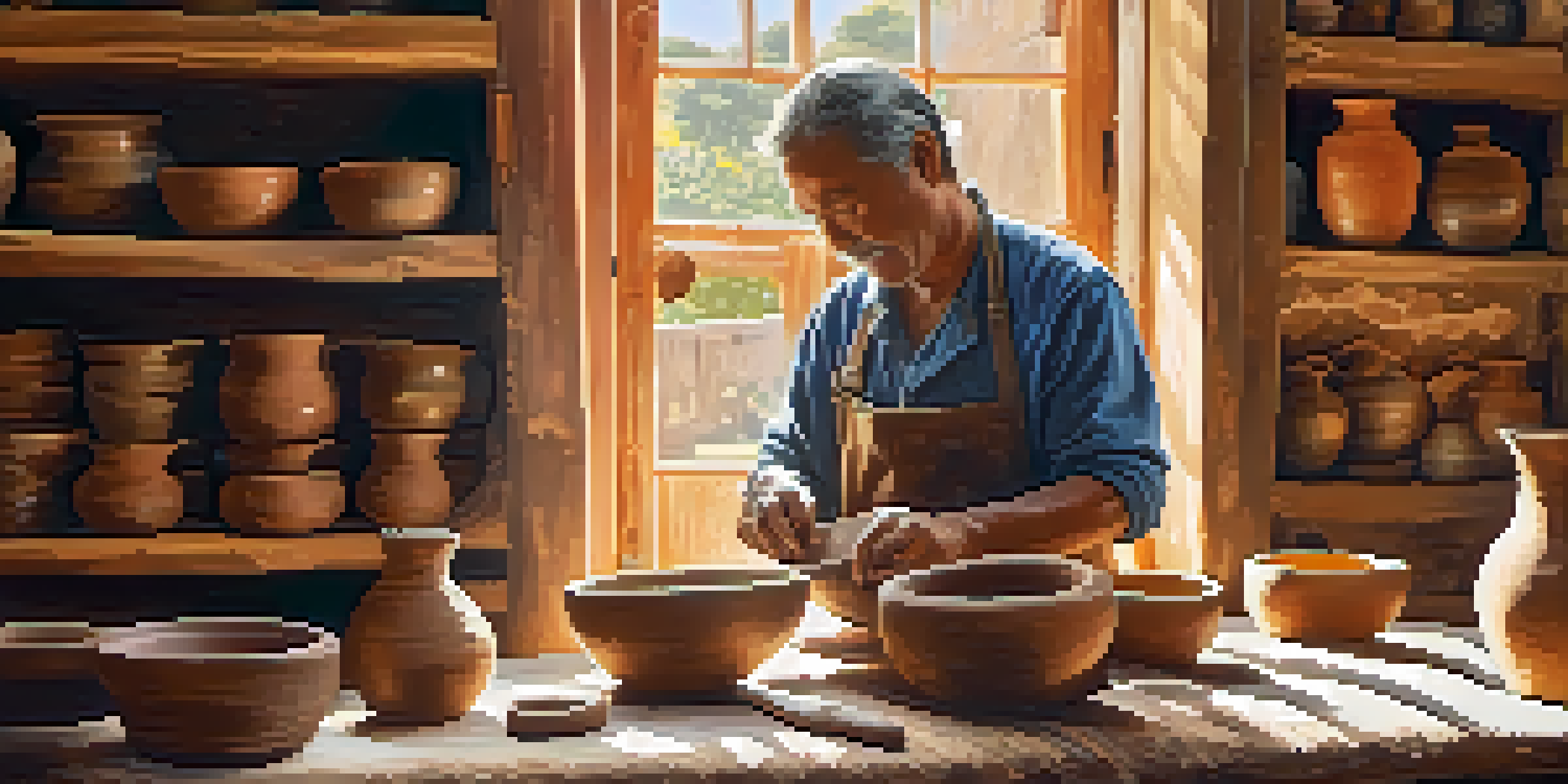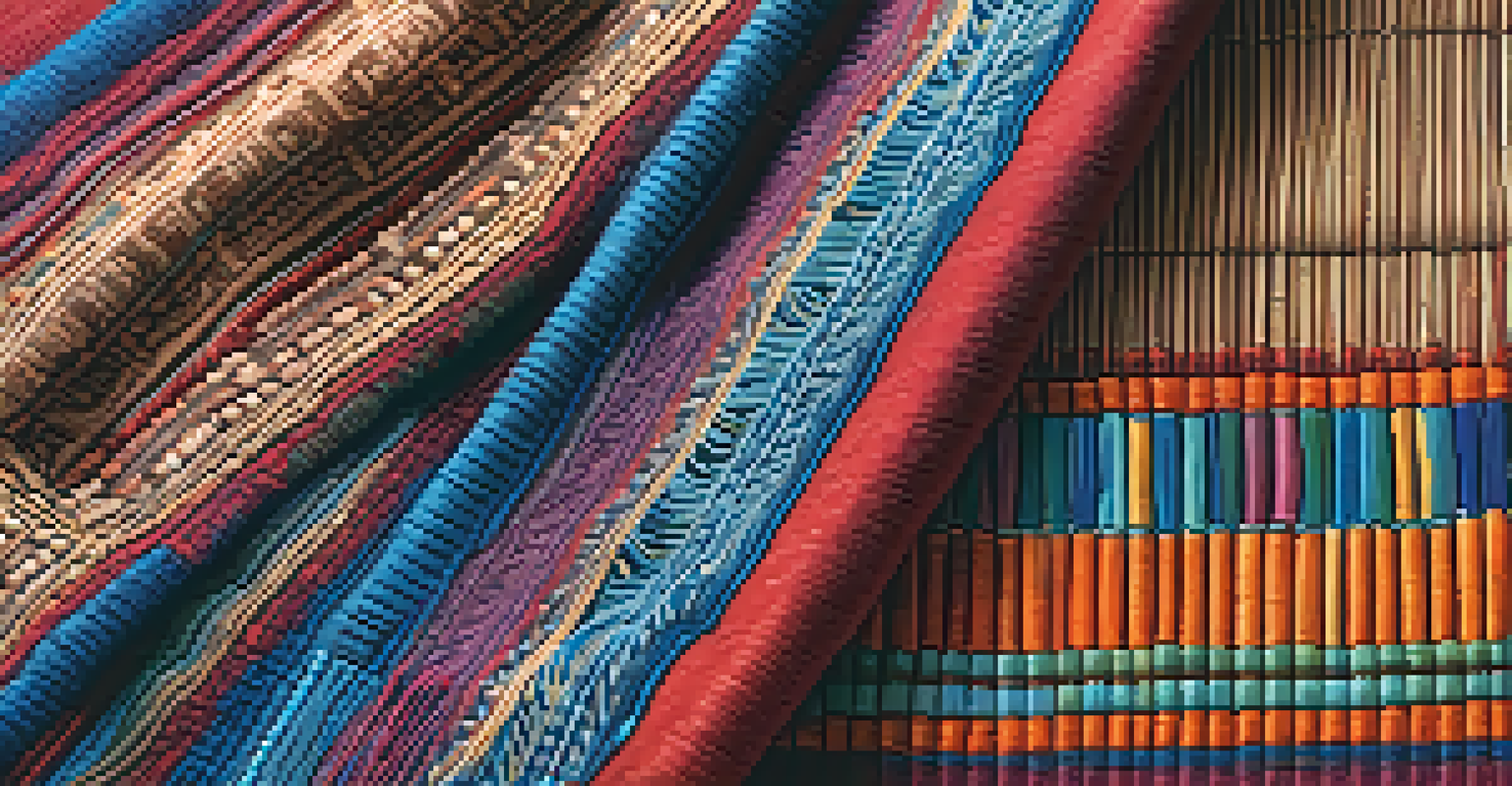Heritage Crafts: The Intersection of Culture and Luxury Goods

Understanding Heritage Crafts and Their Importance
Heritage crafts are traditional skills passed down through generations, often representing the unique culture of a community. These crafts can include pottery, weaving, woodworking, and more, embodying the artistry and techniques of a specific region. By preserving these practices, we not only maintain cultural identity but also offer a glimpse into the history that shapes our society today.
Craftsmanship is the art of making things well, and heritage crafts are a testament to the history and stories behind them.
In a world increasingly dominated by mass production, heritage crafts stand out as a testament to human creativity and craftsmanship. Each piece tells a story, often reflecting the values and traditions of the artisans who create them. This connection to history and identity makes heritage crafts not just items, but valuable cultural artifacts.
Furthermore, as consumers become more conscious of their purchasing choices, the appeal of heritage crafts grows. People are increasingly seeking products that offer authenticity and a connection to the past, making these traditional crafts particularly relevant in today’s luxury market.
The Luxury Market's Embrace of Heritage Crafts
Luxury brands are increasingly incorporating heritage crafts into their offerings, recognizing the value of authenticity. By collaborating with skilled artisans, these brands can create unique products that stand apart from mass-produced alternatives. This not only enhances the brand's image but also supports local communities and preserves traditional crafts.

For instance, high-end fashion houses often use hand-woven fabrics or hand-stitched embroidery in their collections. These elements add a layer of exclusivity and craftsmanship that resonates with luxury consumers. By intertwining cultural significance with luxury, brands create a deeper connection with their clientele.
Heritage Crafts Preserve Culture
Heritage crafts embody unique cultural identities and offer a glimpse into the history that shapes our society.
Moreover, consumers are willing to pay a premium for items that reflect their values, such as sustainability and heritage. This shift towards appreciating craftsmanship over mere brand names showcases how heritage crafts can thrive in the luxury sector, marrying tradition with modern consumer desires.
Cultural Significance Behind Heritage Craftsmanship
Every heritage craft is steeped in cultural significance, often tied to local customs, beliefs, and historical events. For example, the art of Japanese origami is not just about paper folding; it's a practice that reflects the philosophy of patience and precision. Understanding these cultural roots enriches our appreciation for these crafts.
The future belongs to those who believe in the beauty of their dreams, and heritage crafts are the embodiment of those dreams.
Additionally, heritage crafts can serve as a form of storytelling. Each item produced carries the narratives of the artisans, their communities, and the techniques they've honed over the years. This storytelling aspect makes each piece more than just a product; it becomes a vessel of cultural expression.
In a globalized world, recognizing and valuing the cultural narratives behind heritage crafts fosters respect and appreciation for diversity. It encourages consumers to explore not only the beauty of these items but also the rich histories they encapsulate.
Challenges Facing Heritage Crafts Today
Despite their appeal, heritage crafts face numerous challenges in the modern world. The rise of industrialization and fast fashion has led to a decline in traditional craftsmanship, as many artisans struggle to compete with cheaper, mass-produced goods. This threatens the survival of these unique skills and the cultures they represent.
Moreover, younger generations are often drawn to more contemporary careers, leaving behind the traditional crafts that their ancestors practiced. This generational gap can result in a loss of knowledge and skill, which could ultimately diminish the cultural heritage of these crafts. Without intervention, we risk losing invaluable cultural expressions.
Luxury Brands Embrace Authenticity
Luxury brands are increasingly collaborating with artisans to create authentic products that resonate with conscious consumers.
However, initiatives aimed at reviving interest in heritage crafts are gaining momentum. Organizations and NGOs are working to educate and empower artisans, ensuring that traditional skills are passed on to the next generation, thereby safeguarding cultural legacies.
The Role of Technology in Heritage Crafts
Interestingly, technology can play a positive role in promoting heritage crafts. Social media platforms allow artisans to showcase their work to a global audience, creating new opportunities for sales and recognition. This digital exposure can help elevate traditional crafts to a broader market, connecting them with consumers who value authenticity.
E-commerce platforms are also making it easier for artisans to reach potential buyers without the need for a physical store. By selling their products online, craftsmen can tap into the luxury market and cater to consumers who are looking for unique, culturally-rich items. This shift is crucial for sustaining and growing the heritage craft industry.
Furthermore, technology can assist artisans in preserving traditional techniques through digital archives and tutorials. By documenting these practices, we can create a resource for future generations, ensuring that the skills and stories of heritage crafts continue to thrive.
Case Studies of Successful Heritage Craft Collaborations
Several luxury brands have successfully collaborated with heritage artisans, showcasing the beauty of traditional craftsmanship. For example, a renowned fashion brand partnered with local artisans in India to create a line of hand-embroidered garments. This collaboration not only provided a platform for skilled artisans but also infused the brand's collection with rich cultural narratives.
Another inspiring case is the revival of traditional pottery in Italy, where luxury home goods brands have collaborated with local artisans to produce one-of-a-kind tableware. These pieces are often celebrated for their craftsmanship and unique designs, attracting consumers who appreciate the story behind each item.
Technology Supports Craft Preservation
Technology enables artisans to reach global markets and document traditional techniques, ensuring the survival of heritage crafts.
These collaborations not only elevate the luxury brand but also empower local artisans by providing fair wages and recognition. Such partnerships exemplify how the intersection of culture and luxury can create a sustainable model that benefits both parties.
The Future of Heritage Crafts in the Luxury Sector
Looking ahead, the future of heritage crafts in the luxury sector appears promising. As consumers increasingly prioritize authenticity and sustainability, the demand for heritage crafts is likely to grow. This trend signals a shift towards valuing craftsmanship and cultural heritage over mere brand names.
Moreover, with the rise of conscious consumerism, brands that embrace these values will likely find favor among discerning shoppers. By investing in heritage crafts, luxury brands can differentiate themselves in a saturated market, appealing to consumers who seek meaningful connections with their purchases.

Ultimately, the fusion of heritage crafts with luxury goods not only preserves cultural legacies but also enriches the luxury market. As we move forward, fostering a deeper appreciation for these crafts will ensure that they remain a vital part of our global culture.